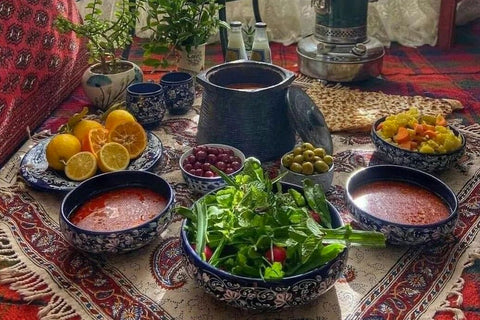Community is integral to most facets of Persian culture, and its cuisine is no different. Food isn’t just a meal, but a major social activity between friends and family – helping strengthen bonds and bringing loved ones together through the joy of food.
The importance of community
The preparation of Persian dishes is traditionally done through shared tasks among a big, extended family. (Such communal activity also extends to other forms of art such as rug weaving, painting, and poetry.) Meals are thus meant to be enjoyed in a family group or social gathering, where main dishes are shared among the rest at the table, rather than served on individual plates.
As such, each participant can then customise their individual plate to their liking - creating their own combination of main meals and side dishes to suit their taste. The table will often provide an extensive selection of food in various forms, colours, and flavours.
In addition, there is typically little difference between restaurant dining and home cooked meals, with households often treating their food just as seriously as professional eateries.
Having guests over
Inviting guests over for a meal is also considered an important custom of Persian culture. Travellers will often find themselves invited by locals into their homes, where they tend to shower their guests with an abundant menu of food. There is often more food than one can eat, though guests are expected to try a little from every dish served.

It is generally considered rude when a guest leaves leftover food on their plate, so it’s important to finish all the food you get from the table to show politeness or gratitude. Guests should also expect to be offered second or third helpings, with initial refusals assumed to be polite gestures and thus not taken seriously.
How food is served
Meals are usually served on a tablecloth (often made of Kalamkari fabric) on individual plates. Knives are typically absent from the table, with food eaten and cut using only spoon and forks. Some foods may be wrapped in bread, known as “Loghmeh”, and are eaten by hand.
In a more traditional household, meals may be served on a sofreh (a tablecloth-like garment) spread on a Persian rug.
Contrary to typical Western dining where entrees, main courses, and desserts are brought to the table at certain intervals, Persian dishes are served on the table simultaneously. This includes the main meals, side dishes, desserts, and drinks. All served to participants at once, with each person customising their plate as they wish.

Persian dining will also commonly feature a platter of herbs for people to eat with their meals, also known as “sabzi khordan”. This typically features a combination of mint, parsley, dill, radish, tarragon, chives, and spring onions, sometimes with naan, walnuts, and feta cheese.
Indulge with your family and friends today!
Shila Kitchen offers a generous menu of delectable Persian meals, each with an authentic "home-made" touch. Enjoy a vibrant dine-in experience or fresh takeaway dishes in the comfort of your own home - along with catering options to make any event or gathering one to remember.
